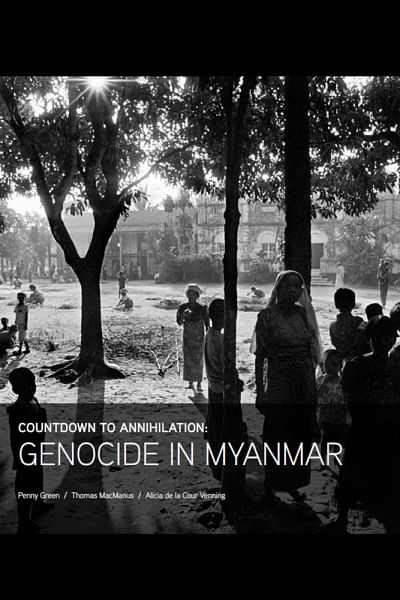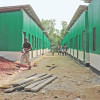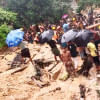The Rakhine — Avatars of Tony Blair?

Two parties are widely blamed for the ethnic cleansing of the Rohingyas: the Myanmar army and Aung San Suu Kyi. They stand amid the embers and ashes of torched Rohingya homes, objects of a furious global condemnation. Yet, the army, a feral beast from deep within a Mahabharat forest, keeps protesting its innocence, while Myanmar's Lady Macbeth sleepwalks through teak-roofed rooms feverishly repeating 'Out, damned spot!' But all to no avail. Prince Charles crossed out Myanmar from his highly symbolic Asia visit list; the frowning visage of Bishop Desmond Tutu looms across the oceans.
But there is another villain in this grisly dystopian tale. Surely the Rakhine were just as hot-wired into the killing fields as the other two; surely, they were one of the signifiers in that ecosystem of death. As our own 1971 history illustrates, a proper genocide needs locals. To drive a stake through the heart of an entire community requires natives. To paraphrase Hillary Clinton, if it takes a whole village to raise a child, it sure as heck takes a whole bunch of them to raze many.
But in the global media coverage of the current crisis the Rakhine were largely missing, thereby escaping the severe censure directed at the other two. Over the years, as fresh atrocities took place, they would show up in the reportage of Human Rights Watch and other such bodies, but what was missing was a detailed, all-encompassing study. The reason for it, of course, was that Myanmar continually barred such investigations and the Rakhine tended to be hostile. Yet, if now they were to be hauled before the court of public opinion, it was necessary to have a precise understanding of their part in the interlocking mechanism of Myanmar's ethnic-cleansing machine. The marauders that appeared in the global journalistic margins were cloaked in the anodyne phrases of "pillaging mobs of youth", or "armed vigilantes" or "groups of young Buddhists", or fleeting images of men racing down rural paths in BBC documentaries, and thus hard to pin down. They sprang up, they terrorised, they disappeared. And sprang up somewhere else. Over time, the reporting on the Rakhine did become sharper (especially in the local Bangla press), but the overall view, like the patches of smoke-covered Myanmar border, remained hazy. The Rakhine, in effect, had become the avatars of Tony Blair, that slipperiest of war criminals—dubbed by a fellow Brit pol as "a mixture between Harry Houdini and a greased piglet, barely human in his elusiveness."
Until the ISCI report showed up in my email inbox.
The International State Crime Initiative is a UK-based, interdisciplinary research centre founded to investigate state crimes such as genocide, war crimes and torture. The June 2012 communal violence in Rakhine state, after which state-organised persecution of the Rohingyas escalated, and later in 2014, when they became boat people, drew its attention. ISCI decided to assess whether the Myanmar government's crimes did indeed amount to a full-scale genocide. It conducted a 12-month study that included a nervy four-month field investigation at ground zero in Rakhine state. The result was the publication in 2015 of Countdown to Annihilation: Genocide in Myanmar, that then represented "the only systematic academic fieldwork on the question of genocide in the Rakhine state."
Genocide studies have come a long way since Attila the Hun, and so unsurprisingly, ISCI utilised an analytical framework very similar to the one used by the Permanent People's Tribunal (PPT) in September in Kuala Lumpur (see CR Abrar's excellent account "Rohingya Genocide: Culpability through denial and inaction", published in The Daily Star, September 24, 2017). Part I of the report gave the historical, political and economic context of the ethnic cleansing, with a focus on state-army-Rakhine relations. Part II was an account of how the reality on the ground was scrupulously tested against the genocide markers in the framework, detailing the processes of the first four stages that had left Rohingyas degraded to "a people whose agency has been completely destroyed." The final two stages—"mass annihilation and their erasure from Myanmar history"—began, as we know all too well, in August 2017.
It most definitely was, the report concluded, a genocide. No two ways about it. It also thereby nailed the Rakhine.
Interspersed among and at various levels of the text of Part II were the field investigations that added up to a devastating picture of the role and actions of the Rakhine state, its civil society and monks, and the Arakan National Party (ANP) in the genocide.
The Rakhine state was the institutional arm of the genocide. It gave, among other things, blanket immunity to the murderous Rakhine thugs. Asked about an arson attack and massacre of Rohingyas in June 2012, the state attorney-general flatly said, "It happened at night time so there is no evidence."
Rakhine civil society was the multi-tasking enabler, stoking the fires of ancient communal prejudices. Its "human rights activism" on land, labour and environmental issues was based on "an extreme form of anti-Rohingya propagandizing"—i.e., that it was the Rohingyas, and not the Myanmar state or the ruling ethnic group the Bamar, who were the cause of Rakhine poverty and underdevelopment.
The Arakan National Party was the attack dog. They attacked Rohingyas. They attacked the offices of the UN and international NGOs distributing relief to the Rohingyas. When, to her credit, Aung San Suu Kyi in 2012 said that she was concerned about the situation in Rakhine state, the ANP attacked her local NLD (the National League for Democracy) party offices multiple times. Instead of resisting, she caved in and never again spoke on the issue. The ANP kept the chokehold on the NLD, and in the build-up to the November 2015 elections, Aung San Suu Kyi reportedly purged her party of its Muslim members and conspicuously did not field any Muslim candidates. After the elections, from the moment she shook hands with the generals, it was open season on the Rohingyas.
The monks were the ideologues. They spread the message of hate against Muslims; they pushed for the destruction of mosques as a defence against 'jihadist Islam' and blessed the Rakhine civil society members and politicians providing transport and refreshments to groups attacking Rohingya villages.
***
The report makes for sickening reading—a validation of Lacan's statement that human history is a "sewer." What was perpetrated on the Rohingyas was awful. Simply awful.
It is especially difficult to look at the Rohingya children in the camps, gazing wide-eyed at their brave new world. The cruelty inflicted on them will be a stain forever on all the three parties, but especially on the Rakhine, for these children lived side by side with them.
The Yemeni poet Ahmed Al-Shami wrote about the loveless and the forlorn; his poems could apply equally to these children:
Ride, ride the horse of your despair;
Do not hark back to what you left behind.
The land you cross, love will not be there,
No fated meeting, no melodious air,
No welcome waits for you, and hope is blind.
Once and for all your halcyon days are gone;
All those ghosts behind you! You…
Dare now the dark to eat the light
you're riding through.
Khademul Islam is the editor of the literary journal Bengal Lights.










Comments